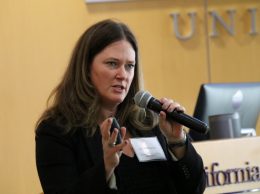Policy normalization must continue

Dan Hamilton
By Dan E. Hamilton
Since 2008, the Federal Reserve has been engaged in an unprecedented experiment, one without any economic theory to recommend it. Its policies are internally inconsistent. Some work to restrict credit. Others ease credit.
The 2007 failure of New Century Financial, a leading subprime lender, did not derail the economy. However, when Lehman Brothers filed for Chapter 11 bankruptcy protection in September 2008, many observers knew that a negative regime shift had occurred. The economy suffered the worst single-quarter contraction since 1958.
While the Fed had reduced its short-term target interest rate in late 2007 and early 2008, it had held it steady from April 2008 until Lehman’s collapse. Once Lehman Brothers fell, policymakers responded aggressively, reducing the federal funds target to 1 percent by October and to 0.125 percent in December. The Fed also established an interest rate on required and excess reserve balances of 0.25 percent, a previously untested policy.
The Fed initiated its first round of quantitative easing (QE), which attempts to reduce long-term interest rates directly, in November 2008. By 2012, the economy and average monthly job numbers were growing by respectable amounts for a post-recession economy. Still, the Fed announced a third round of QE in September of 2012, adding that it would likely maintain its policy rate near zero “at least through 2015,” believing the economy was too weak to stand on its own.
The economic theory behind the choice of target rate is that the Fed should follow a rule that provides guidance based on various economic indicators. There is evidence that following such a policy rule is optimal. The policy changes of late 2008 and 2009 somewhat followed the rule. However, by most calculations, the target rate should have been raised significantly above its near-zero level in 2012.
The zero interest rate and QE policies have pernicious impacts. They distort decisions about saving, investing and portfolio composition. They can also lead to asset price bubbles. The zero interest rate policy also restricts the Fed from reducing the short-term policy rate in the future, for example, if the economy weakens again.
The excess reserves policy was unprecedented. Paying interest on excess reserves incentivizes banks to hold greater reserves with the Fed rather than lend. This policy restrains credit and economic growth. It works in direct opposition to the Fed’s expansionary target rate policy.
Presumably, the Fed does this to support big banks that still have bad assets. Because lending is risky, it can be optimal for banks with bad assets to park funds at the Fed, receiving a guaranteed or risk-free return. While this was relevant five years ago, I question the continued use of this policy as bank charge offs normalized by gross domestic product are now historically low.
The Fed finally raised the target short rate, just a bit, in December, after seven years of maintaining it at nearly zero. The QE policies were left unchanged. However, the Fed simultaneously raised the interest rate paid on reserves from 0.25 to 0.50 percent. While one policy was moved toward normal, another was moved farther away from normal.
The Fed also embarked on a policy of bank consolidation in late 2008. This policy adds risk to the economy. The combined assets of the 10 largest banks are approaching half the size of GDP.
Size like this matters. It changes behavior. The large banks know they will be bailed out in the event of failure, so they take on greater risks. If the risks pan out, they enjoy greater profits, and if they don’t, they are insured. Taxpayers bear the insurance costs.
The Fed should move in the direction of normalization with respect to all of its policies, not just some of them. The economy will be less distorted and less risky. Taxpayers would less likely be on the hook to pay for a bailout. Lending would increase. Those who prefer low-risk investments would receive greater returns. Inflated asset prices would subside. These would be better policies in the long run.
Moreover, the Fed would be free to lower the short-term rate to fight off future recessions.
• Dan E. Hamilton is the director of economics for the Center for Economic Research and Forecasting and an associate professor of economics at California Lutheran University.











